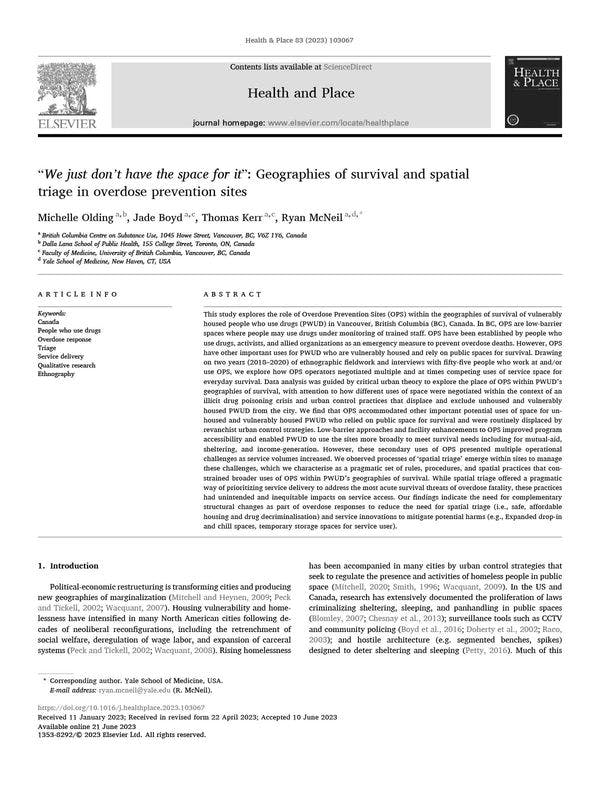« Nous n'avons tout simplement pas l'espace pour cela » : Géographies de la survie et triage spatial dans les sites de prévention des overdoses
Olding et al. soulignent les nombreuses fonctions que les sites de prévention des overdoses jouent dans la vie des gens et la façon dont les adaptations à une forte demande peuvent avoir des impacts involontaires sur ces fonctions, soulignant l'importance de changements structurels et d'innovations de service complémentaires. Pour en savoir plus, en anglais, veuillez lire les informations ci-dessous.
Highlights
- Examines the roles of overdose prevention sites (OPS) within people who use drugs' (PWUD) geographies of survival.
- Beyond overdose prevention, PWUD used OPS for mutual aid, sheltering, and income generation.
- Operational challenges and tensions emerged around these uses of space as service volumes increased.
- OPS enacted rules and processes to triage how service space could be used.
- Spatial triage unintentionally and disproportionately impeded OPS use by women, Indigenous and unhoused PWUD.
Abstract
This study explores the role of Overdose Prevention Sites (OPS) within the geographies of survival of vulnerably housed people who use drugs (PWUD) in Vancouver, British Columbia (BC), Canada. In BC, OPS are low-barrier spaces where people may use drugs under monitoring of trained staff. OPS have been established by people who use drugs, activists, and allied organizations as an emergency measure to prevent overdose deaths. However, OPS have other important uses for PWUD who are vulnerably housed and rely on public spaces for survival. Drawing on two years (2018–2020) of ethnographic fieldwork and interviews with fifty-five people who work at and/or use OPS, we explore how OPS operators negotiated multiple and at times competing uses of service space for everyday survival. Data analysis was guided by critical urban theory to explore the place of OPS within PWUD’s geographies of survival, with attention to how different uses of space were negotiated within the context of an illicit drug poisoning crisis and urban control practices that displace and exclude unhoused and vulnerably housed PWUD from the city. We find that OPS accommodated other important potential uses of space for unhoused and vulnerably housed PWUD who relied on public space for survival and were routinely displaced by revanchist urban control strategies. Low-barrier approaches and facility enhancements to OPS improved program accessibility and enabled PWUD to use the sites more broadly to meet survival needs including for mutual-aid, sheltering, and income-generation. However, these secondary uses of OPS presented multiple operational challenges as service volumes increased. We observed processes of ‘spatial triage’ emerge within sites to manage these challenges, which we characterise as a pragmatic set of rules, procedures, and spatial practices that constrained broader uses of OPS within PWUD’s geographies of survival. While spatial triage offered a pragmatic way of prioritizing service delivery to address the most acute survival threats of overdose fatality, these practices had unintended and inequitable impacts on service access. Our findings indicate the need for complementary structural changes as part of overdose responses to reduce the need for spatial triage (i.e., safe, affordable housing and drug decriminalisation) and service innovations to mitigate potential harms (e.g., Expanded drop-in and chill spaces, temporary storage spaces for service user).
Régions
Profils associés
- Health & Place
